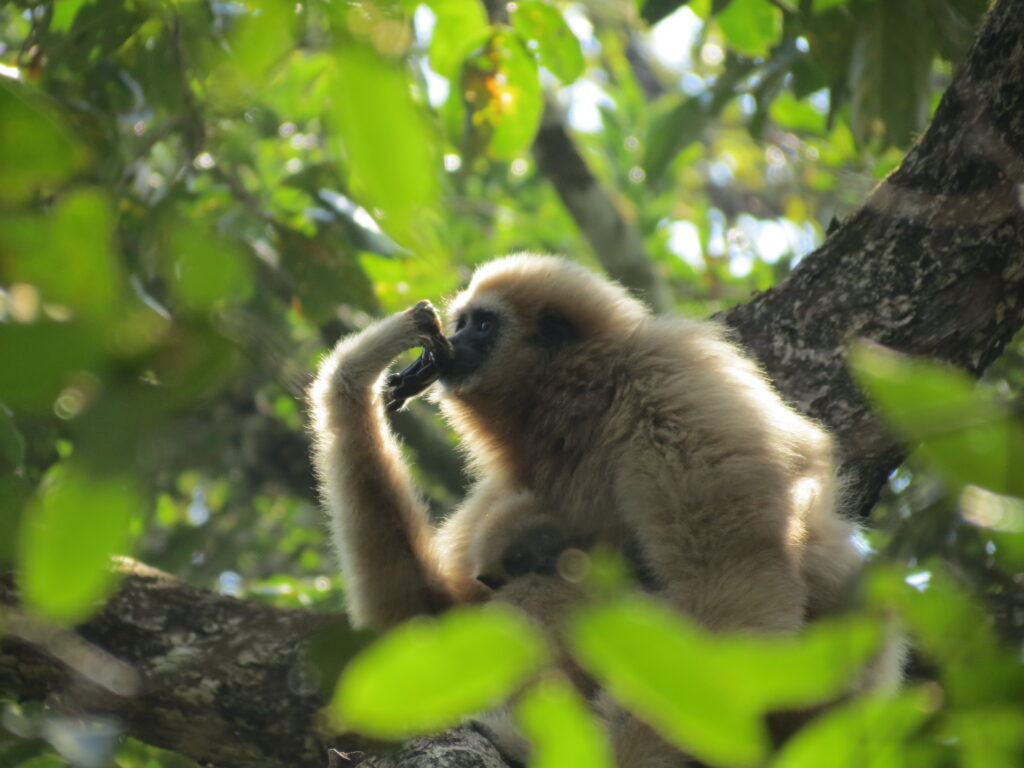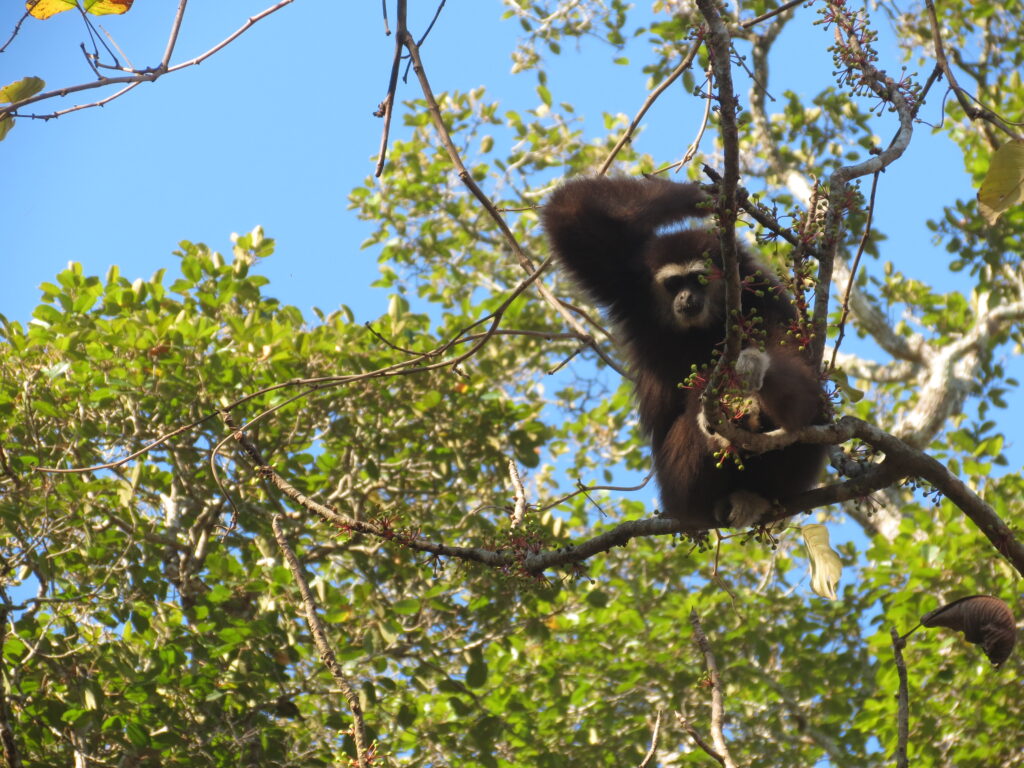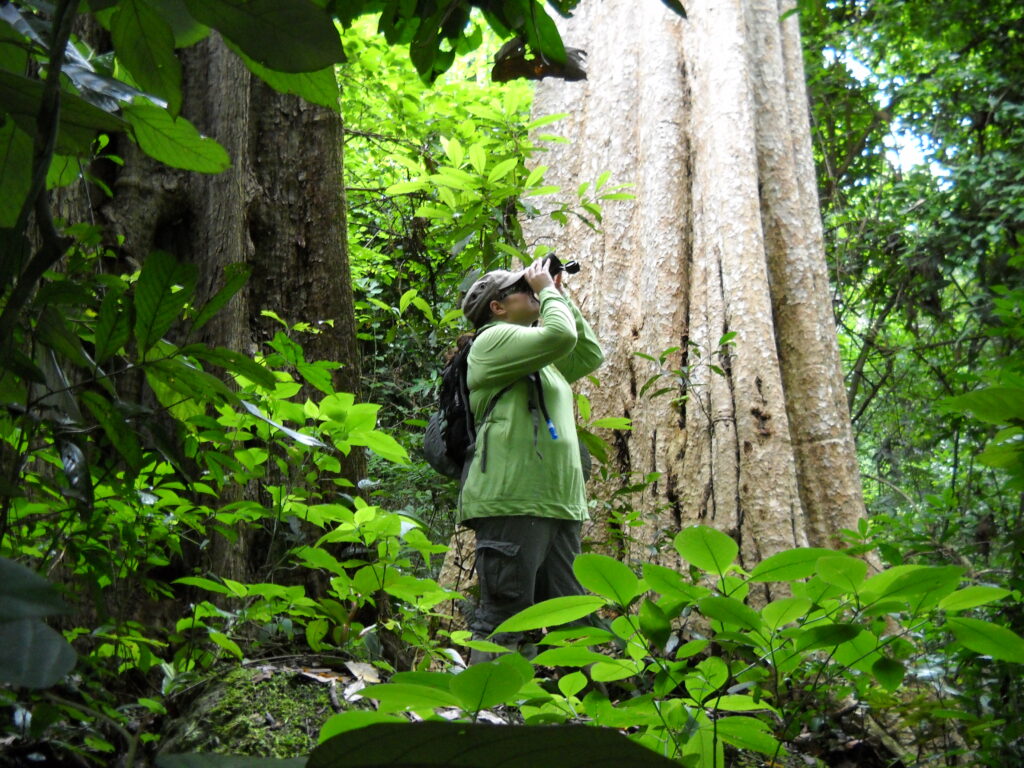As people react to the 2020 U.S. presidential election results, we have turned to the animal kingdom to see how animal societies make decisions and resolve conflict. We asked CLAS researchers to consider what we can learn from animal societies.
Here are our experts:
- Alan Rauch, an English professor, earned degrees in zoology and literature, and he studies and writes about dolphins.
- Stanley Schneider, a biologist, studies honey bees and their hive behavior.
- Anthropologist Lydia Light researches gibbons and other primates.
Alan Rauch – Dolphins
How do the animals you research make decisions?
Rauch: Dolphin societies are predominantly matriarchal, so a good deal of the decision-making rests in the hands (flippers) of the older and more established females. The communication and social skills of dolphins are very complex and extremely subtle. Dolphins can communicate by whistles that allow them to mediate information about who they are and where they are. Of course, we are a long way from understanding what each whistle means. Clearly though, dolphins make precise decisions, whether it has to do with synchronous swimming or well-regulated hunting.
Aside from whistles, dolphins are also capable of very high frequency sonar, which they may be able to share. And so when a school of fish swim nearby, a sonar scan of what’s called the ”bait ball” is probably picked up by other dolphins in the dolphin pod. Then, individual dolphins take turns swimming through the bait ball and feeding. How the order is established is unclear, but there is no free-for-all, so the dolphins surely have an understanding of order and priority.
What are some of the situations they face when they need to have group decision-making?
Rauch: Dolphins need to engage in group decisions while foraging for food as well as when moving locations. Given that there can be any number of dolphins in a pod, averaging around 15-25, but sometimes as many as 100-150, group coordination and communication is important. The older and more experienced dolphins must agree on the time of movement and the direction of movement.

Dolphins must also work quickly and alertly – in concert – if predators, such as sharks, are nearby. In these scenarios, it is possible that dolphins release alarm chemicals in the water to alert others – quietly and without drawing attention to themselves or their young – that danger is nearby. Sleep is a complicated process in dolphins even though they seem capable of resting half their brain at any one time. But resting still makes individuals vulnerable as they float near the surface. Thus dolphins coordinate sleeping behavior with guarding behavior and take turns keeping watch while others sleep.
Finally, young calves are particularly vulnerable to predation, and they do swim very closely with their mothers. But there is a clear system of “Auntie” dolphins who do not have young of their own, but swim near mothers with calves and will often guard the calves while the actual mother forages for food.
What do the animals you study do when there is conflict in their group, particularly as decisions are being made?
Rauch: Dolphins can be very “outspoken”! Disagreement is signaled by tail slaps which may simply be on the surface of the water or, if there is need, a slap directed bodily at another dolphin. Other gestures of disagreement include “raking” when one dolphin runs its teeth superficially – but firmly – against the body of another dolphin, or a person. I’ve been raked, and it doesn’t hurt, but you do feel it.
Sound communication can precipitate group movements, but it has also been observed that group movements can be initiated by side flops, often by males, and the movement is terminated by slapping the tail gently while upside down. Since dolphins are so vocal, it is hard to know if these gestures also have specific clicks or whistles associated with them, the way we might vocalize “let’s go” while also clapping our hands together.
Stanley Schneider – Honey bees
How do the animals you research make decisions?
Schneider: I study honey bees, and many decisions are made at the “colony level” through decentralized, collective decision-making processes. Examples include choosing a new nest site by a honey bee swarm, organizing the nest into brood rearing areas and food storage areas, preparing for long-distance travel, comb building, social immunity, etc. In all cases, individual bees act on only local information using innate rules. The colony level patterns and decisions then emerge collectively. There is no centralized control of the decision-making processes.
What are some of the situations they face when they need to have group decision-making?
Schneider: Honey bees use group decision-making when they are finding a new nest cavity and building and organizing the combs. They also need to work as a group when deciding when to raise drones (males) and how many to rear; and when to raise new queens. They decide together who inherits the nest. African bees work as a group when deciding to migrate to a new area.

What do the animals you study do when there is conflict in their group, particularly as decisions are being made?
Schneider: Honey bee societies are organized very differently from mammalian societies, in that they are not based on a dominance hierarchy, and there is little overt aggression or conflict among workers within a nest. There is not conflict and disagreement; rather, there are differences of opinion. For example, when a swarm is searching for a new nest site, scout bees individually fly out to find possible cavities, and they assess the quality of the cavity using innate rules. If they like what they find, they then return to the swarm and perform waggle dances on the swarm surface to communicate to other workers the location of the cavity they found. The dance followers can then leave the swarm and investigate the cavity, and if they like it too they return and perform their own waggle dances for it to recruit others.
Initially, scout bees may advertise 12-20 different possible new nest cavities, but eventually all waggle dancing becomes focused on one cavity and when that happens the swarms moves to that chosen site. Thus, in essence the scout bees and their followers “vote” for which site is best. But they don’t do this through direct comparison. The majority of scouts only ever visit and dance for one nest site. They do not follow dancers for other sites, go visit those, and then switch their dancing to the other site if they like it better than the first one they found.
Each scout will dance for its site, then leave the swarm and revisit the site, then return and dance again, etc. But each time it returns to the swarm it dances less until finally it ceases dancing altogether. If it’s visiting a good quality site, then it dances longer each time it is on the swarm than do bees dancing for lower quality sites. In this way, there is more dancing and recruitment for the better sites and dancing for the poorer sites dwindles and dies away. The bees recruited by these dances follow the same rules and the end result is that eventually all bees are dancing for the same site (the best one they found), and dances for all other sites cease.
Thus, the “voting” is based on level of excitement and interest about the “candidate”. But there is no “bad mouthing” other choices. Only the best site can sustain the interest to keep the dancing and recruitment going until it ends up the unanimous winner. Even though bees dance for different sites, there is no conflict involved. However, bees that dance for the best site will butt their heads against a dancer for a different site and produce a “stop signal” (a short beep), which essentially says “please do shut up.” This helps to focus dancing on the best site. Then, once a site is chosen, the entire swarm must make the decision to become airborne at once and move to the new site.
Lydia Light – Gibbons
How do the animals you research make decisions?
Light: I study white-handed gibbons, a species of small apes that lives in the tops of the trees in forests throughout parts of Thailand and Malaysia. They live in small groups with one male, one female, and a few younger individuals. We used to describe gibbons as “monogamous,” but now we know they live in much more complicated social groups with some individuals living together throughout their lives, yet others might re-pair several times either because of the death of their mate or because either one of the pair deserts the group to seek other opportunities.
Based on my research and the research of other scholars, we also know now that this species of gibbon can sometimes live in groups with multiple adult males. However, the groups are very cohesive regardless of the composition. The group travels together as they range through their territory looking for food and patrolling the boundaries.
When the group moves to a new location, that decision is made by the adult female. This is thought to be based on the female’s higher nutritional needs due to pregnancy and lactation. The female will lead the group from feeding tree to feeding tree, quite deliberately, following regular pathways through the canopy of the forest and heading intentionally to the next food resource.
Since the female is focused on finding food resources, the male follows along and opportunistically looks for neighboring groups. If they come across one (usually only when they are close to the boundary of the territory), the male takes the lead in trying to scare away the other group, using loud vocalizations and swinging aggressively through the trees in sight of the other group. If the female helps, she just vocalizes from wherever she is feeding.
The female also decides when it is time to rest or socialize, usually after a big feeding bout, and when it is time to go to sleep. So put quite simply, for white-handed gibbons, the female makes the decisions, and the male follows her lead.
What are some of the situations the they face when they need to have group decision-making?
Light: For gibbons, this is almost entirely about defending the territory against other gibbons. Sometimes (probably only when there is a lot of food around and they have time for nonessential behaviors), neighboring groups might socialize together and even let the young ones play together. Gibbons are territorial, so they stay in one place and do not need to plan for moving anywhere new as a group. However, individuals might choose to leave a group and join a new one that either does not have an adult of that sex, due to death or desertion, or has a current member that can be easily displaced.
Some of my research has shown that even if the membership of the group changes, the territory stays the same. Since most gibbon populations live in areas where the suitable habitat is saturated with gibbon groups, this makes it nearly impossible for groups to move anywhere together.
The most common situations where I have observed group members working together were those in which the group came across another gibbon group and they had to defend the territorial border, which is likely always in dispute.
Besides that, gibbons also seem to work together when encountering other species that might want their food or pose a threat to their safety. I do research in a place with an impressively high amount of biodiversity, and gibbons frequently encountered langur monkeys, macaque monkeys, hornbills, and giant squirrels eating out of their food trees.
The gibbons differed by group as to how they reacted to these potential food-thieves, with some groups avoiding the macaques but coexisting with the langurs peacefully and other groups the exact opposite. There were often vocal “battles” with the giant squirrels and hornbills where several of the gibbons would call at the other animals and those animals would call in response, but there was never any physical aggression.
Besides food competition, the gibbons only ever reacted to elephants. Elephants can easily knock over even some of the largest trees the gibbons spend time in so when one comes by, whoever sees it first raises an alarm, and everyone starts calling. Interestingly, this seems to have an immediate effect on the group members themselves but then also serves to warn all the neighboring groups as well, as they continue calling until the elephants have left the area, even if they are all huddled in the same big tree and fully aware of the elephants right below them.
What do the animals you study do when there is conflict in their group, particularly as decisions are being made?
Light: Despite the description of an idyllic lifestyle swinging from fruit tree to fruit tree, there is occasional conflict in gibbon groups. This might be because the male wants to mate and the female is not interested. In this case, she just keeps turning away until he gets tired of trying. If he is really persistent, she will likely smack him with increasing intensity.
But in the groups I spend the most time observing, the extra males cause a bit of additional conflict. Interestingly, this was not about mating opportunities. One of my groups, Study Group D, had three males of breeding age. In one week, I observed the adult female (Daisy) copulate with all three males (Denison, Darwin, and Downey).
None of the males fought with one another or seemed to be upset. But after that, whenever Denison or Downey entered the same tree as Darwin was in, he made a high-pitched vocalization and ran over to them and hugged them.
Gibbon pairs sing coordinated duets that are thought to advertise their pair-bond and for the first several months I observed group D, Daisy sang with Denison. After the week of multiple copulations, Denison and Darwin took turns singing with her and I assumed Darwin would take over as the primary male.
But when the infant was born, Downey started duetting with Daisy; Denison started spending more time at greater distances from Daisy; and Darwin started this squeak-hugging behavior directed at Downey. I never saw it in any of the other three groups I observed. In the months that followed, Darwin began spending time away from the group but would sometimes go off with one of the other males.
Daisy was never left alone with the immature individuals. There is no literature to support this yet, but it seemed to me that the males were wanting to do something different from feeding and because there were so many of them, they finally had a chance to travel independently. There was no direct conflict but it does seem to me that whenever there is a “difference of opinion” on what to do or where to go, gibbons tend to choose to temporarily go their separate ways for a few hours, joining back together before the end of the day or if there is a need for teamwork, such as when a neighboring group gets too close to invading the territory.
Words: Compiled by Lynn Roberson, CLAS Communications Director | Images: Courtesy of the researchers












